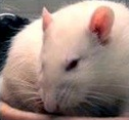A. INTENSITY RATINGS
Score
AU moderately visible
1
AU pronounced
2
Intensity ratings are coded for each AU (Action Unit).
B. ACTION UNITS
1. Orbital Tightening*
Rats in pain display a narrowing of the orbital area, a tightly closed eyelid, or an eye squeeze. An eye squeeze is defined as the orbital muscles around the eyes being contracted. The nictitating membrane may be visible around the eye and becomes more pronounced as the pain intensifies. As a guideline, any eye closure that reduces the eye opening by more than half should be coded as a “2”.
*Note that sleeping rats display closed eyes, but of a relaxed nature, whereas a rat in pain may display a closed eye with tight orbital muscles.
Not present = 0
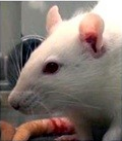
Moderately visible = 1
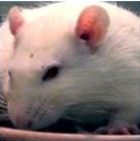
Pronounced = 2
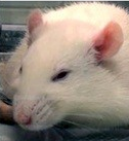
2. Nose/Cheek Flattening
Rats in pain display a lack of bulge on top of the nose (i.e., a flattening of the nose). In the “no pain” condition a clear bulge is present at the bridge of the nose. The whisker pads are also rounded and slightly puffed out, leaving a clear crease between the pads and the cheek. When in pain, the bridge of the nose flattens and elongates, causing the whisker pads to flatten. At this time the crease between the pads and the cheek is no longer present. In frontal headshots, the nose may appear narrower and longer.
Not present = 0

Moderately visible = 1

Pronounced = 2

3. Ear Changes (position, orientation, shape)
The ears of rats in pain may be curled and pointed more than in the baseline position. In the baseline position ears are roughly perpendicular to the head, face forward, and are angled slightly backward. Importantly, the ears also have a rounded shape. In pain, the ears tend to fold, curl inwards and are angled forward. This curling of the ears tends to result in a “pointed” shape of the ears. In pronounced pain states, the ears are angled outward and are held close to 45° away from both the perpendicular axis and the nose. As a result, the space between the ears may appear wider relative to baseline.
Not present = 0
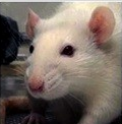
Moderately visible = 1

Pronounced = 2

4. Whisker Changes
Rats in pain have whiskers that have moved from the baseline position and orientation. Whiskers start relaxed and drooping slightly downwards and, as pain progresses, tension in the pads increases and they become angled back along the head. In pain, the whisker pad is contracted causing the whiskers to bunch and be directed outwards away from the face. This gives the appearance of the whiskers as “standing on end”. As follicles become tense, whiskers are closer together and are less distinct.
Not present = 0

Moderately visible = 1

Pronounced = 2
